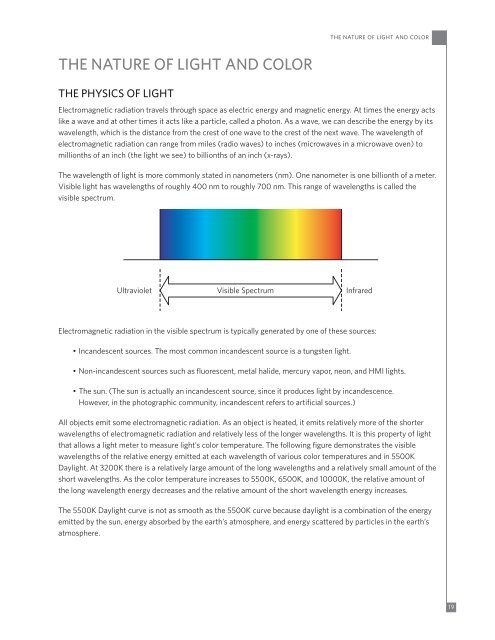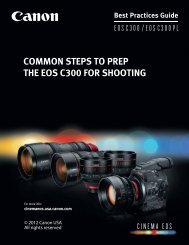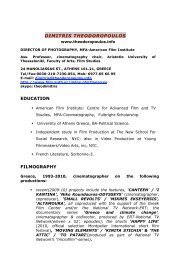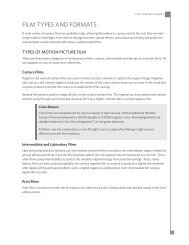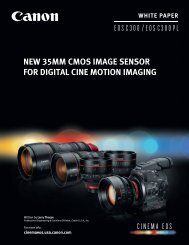THE NATURE OF LIGHT AND COLOR - Kodak
THE NATURE OF LIGHT AND COLOR - Kodak
THE NATURE OF LIGHT AND COLOR - Kodak
You also want an ePaper? Increase the reach of your titles
YUMPU automatically turns print PDFs into web optimized ePapers that Google loves.
<strong>THE</strong> <strong>NATURE</strong> <strong>OF</strong> <strong>LIGHT</strong> <strong>AND</strong> <strong>COLOR</strong><br />
<strong>THE</strong> <strong>NATURE</strong> <strong>OF</strong> <strong>LIGHT</strong> <strong>AND</strong> <strong>COLOR</strong><br />
<strong>THE</strong> PHYSICS <strong>OF</strong> <strong>LIGHT</strong><br />
Electromagnetic radiation travels through space as electric energy and magnetic energy. At times the energy acts<br />
like a wave and at other times it acts like a particle, called a photon. As a wave, we can describe the energy by its<br />
wavelength, which is the distance from the crest of one wave to the crest of the next wave. The wavelength of<br />
electromagnetic radiation can range from miles (radio waves) to inches (microwaves in a microwave oven) to<br />
millionths of an inch (the light we see) to billionths of an inch (x-rays).<br />
The wavelength of light is more commonly stated in nanometers (nm). One nanometer is one billionth of a meter.<br />
Visible light has wavelengths of roughly 400 nm to roughly 700 nm. This range of wavelengths is called the<br />
visible spectrum.<br />
Ultraviolet<br />
Visible Spectrum<br />
Infrared<br />
Electromagnetic radiation in the visible spectrum is typically generated by one of these sources:<br />
• Incandescent sources. The most common incandescent source is a tungsten light.<br />
• Non-incandescent sources such as fluorescent, metal halide, mercury vapor, neon, and HMI lights.<br />
• The sun. (The sun is actually an incandescent source, since it produces light by incandescence.<br />
However, in the photographic community, incandescent refers to artificial sources.)<br />
All objects emit some electromagnetic radiation. As an object is heated, it emits relatively more of the shorter<br />
wavelengths of electromagnetic radiation and relatively less of the longer wavelengths. It is this property of light<br />
that allows a light meter to measure light’s color temperature. The following figure demonstrates the visible<br />
wavelengths of the relative energy emitted at each wavelength of various color temperatures and in 5500K<br />
Daylight. At 3200K there is a relatively large amount of the long wavelengths and a relatively small amount of the<br />
short wavelengths. As the color temperature increases to 5500K, 6500K, and 10000K, the relative amount of<br />
the long wavelength energy decreases and the relative amount of the short wavelength energy increases.<br />
The 5500K Daylight curve is not as smooth as the 5500K curve because daylight is a combination of the energy<br />
emitted by the sun, energy absorbed by the earth’s atmosphere, and energy scattered by particles in the earth’s<br />
atmosphere.<br />
19
<strong>THE</strong> <strong>NATURE</strong> <strong>OF</strong> <strong>LIGHT</strong> <strong>AND</strong> <strong>COLOR</strong><br />
1.2<br />
1<br />
3200K<br />
5500K<br />
6500K<br />
10,000K<br />
5500K Daylight<br />
0.8<br />
Relative Energy<br />
0.6<br />
0.4<br />
0.2<br />
0<br />
400 450 500 550 600 650 700<br />
Wavelength in Nanometers<br />
Relative spectral energy curves for different color temperatures.<br />
When the electrons in a molecule or a gas are excited, they rise to a higher energy level within that atom or<br />
molecule. After a period of time, the electrons return to their normal energy level and emit the difference in<br />
energy as electromagnetic radiation. The energy emitted is frequently in the visible spectrum. The figure below<br />
shows the HMI and Xenon lamp spectral curves compared to the 5500K Daylight curve.<br />
1.2<br />
HMI<br />
Xenon<br />
5500K Daylight<br />
1<br />
0.8<br />
Relative Energy<br />
0.6<br />
0.4<br />
0.2<br />
0<br />
400 450 500 550 600 650 700<br />
Wavelength in Nanometers<br />
20<br />
Relative spectral energy curves for the HMI and Xenon lamps compared to the 5500K Daylight curve.
<strong>THE</strong> <strong>NATURE</strong> <strong>OF</strong> <strong>LIGHT</strong> <strong>AND</strong> <strong>COLOR</strong><br />
When light strikes an object, the light can be transmitted, absorbed, or reflected. In many cases, all three occur.<br />
Transmission, absorption, or reflection can be determined by the wavelength of the light. For example, a piece of<br />
clear glass will transmit all the wavelengths of light striking the surface of the glass. If the glass is colored, some<br />
wavelengths are absorbed and some wavelengths are transmitted. If there are small particles in the glass, some<br />
of the wavelengths may be absorbed, some transmitted, and all reflected. In this case we would describe the<br />
glass as both colored and opaque. A piece of colored paper reflects some wavelengths, absorbs some<br />
wavelengths, and transmits no light.<br />
If light strikes the surface of a transmitting object at an angle other than straight on, the light will be bent as it<br />
enters and exits the object. This property of light allows a lens to focus the light rays on a surface, such as the<br />
surface of the film used to photograph an object. Additionally, the short wavelengths are bent more than the long<br />
wavelengths. It is this property of light that produces a rainbow. As the light enters a water droplet, the light is<br />
bent. The light then reflects off the back of the water droplet. Then, as the light exits from the water droplet, the<br />
light rays bend again. Because the short wavelengths are bent more than the long wavelengths, the wavelengths<br />
of light are spread across the sky and we see the rainbow.<br />
<strong>COLOR</strong> VISION<br />
Vision starts when light from a scene<br />
enters your eye. The lens in your eye<br />
focuses the light as an image onto your<br />
retina. The human retina uses two types<br />
of cells to sense the light: rods and<br />
cones. These microscopic sensors are<br />
distributed across the retina, and each<br />
type serves a very different purpose.<br />
The rods and cones convert light into<br />
minute electrical impulses, which travel<br />
along nerve fibers to the brain. At the<br />
brain, they’re translated into an<br />
impression of the shape and color of<br />
the observed object.<br />
IRIS<br />
PUPIL<br />
RETINA<br />
RODS & CONES<br />
OPTIC NERVE<br />
All rods have the same sensitivity to the wavelengths of light and, therefore, cannot see the color of an object.<br />
Rods see all objects as shades of gray. Because the rods are also very sensitive to light—much more sensitive to<br />
light than cones—they enable us to see in very low light levels, such as a night scene illuminated only by the stars<br />
or the moon. In bright scenes the rods are flooded with light and they cease to produce the signal that the brain<br />
uses for vision. In high brightness scenes only the cones provide useful information to the brain.<br />
There are three types of cones: one has the greatest sensitivity to the long wavelengths of visible light; one has<br />
the greatest sensitivity to the middle wavelengths of visible light; and one has the greatest sensitivity to the short<br />
wavelengths of visible light.<br />
We perceive brightness based on the total level of the signal coming from all the cones. We perceive color based<br />
on the relative signal levels coming from the three types of cones. When the cones sensitive to the long<br />
wavelengths are predominantly stimulated, we see red; when the cones sensitive to the middle wavelengths are<br />
predominantly stimulated, we see green; and when the cones sensitive to the short wavelengths are<br />
predominantly stimulated, we see blue. Because there are only three types of cones, all vision is based on these<br />
three color perceptions. Therefore, most colors are described as light or dark and a combination of two colors, for<br />
21
<strong>THE</strong> <strong>NATURE</strong> <strong>OF</strong> <strong>LIGHT</strong> <strong>AND</strong> <strong>COLOR</strong><br />
example, red and blue (a reddish-blue or a bluish-red). Because of the processing of the signals from the cones in<br />
the brain, we cannot see a greenish-red or a reddish-green. The combination of red and green gives the sensation<br />
of yellow. Therefore, the object appears as greenish-yellow or yellowish-green. These sensations are the result of<br />
different amounts of signals from the red and green sensitive cones. When those signals are exactly the same, we<br />
see yellow with no red and no green.<br />
The figure below shows the sensitivity of the rods and the three types of cones to the wavelengths of visible light.<br />
1.2<br />
1<br />
Red Cone Sensitivity<br />
Green Cone Sensitivity<br />
Blue Cone Sensitivity<br />
Rod Sensitivity<br />
0.8<br />
Relative Energy<br />
0.6<br />
0.4<br />
0.2<br />
0<br />
400 450 500 550 600 650 700<br />
Wavelength in Nanometers<br />
Spectral sensitivities of the human rods and red, green, and blue sensitive cones<br />
Film spectral sensitivities are similar to the sensitivities of the cones. The following figure compares the cone and<br />
film spectral sensitivities. There are a number of reasons for the differences in the film and cone spectral<br />
sensitivities. The large overlap of the red and green cone sensitivities requires a considerable amount of image<br />
processing in the brain in order to produce the sensations of redness and greenness. Film is not capable of that<br />
much image processing. Scanned film could be processed much as the brain processes the cone signals, but the<br />
image processing increases the graininess, or noise, in the resulting image. Also, because images are typically<br />
viewed in lower lighting conditions than those present during photography, the color must be boosted in order for<br />
the projected motion picture images to appear natural. By shifting the spectral sensitivities in the film, it is easier<br />
to chemically or digitally boost the color in the resulting film image.<br />
22
<strong>THE</strong> <strong>NATURE</strong> <strong>OF</strong> <strong>LIGHT</strong> <strong>AND</strong> <strong>COLOR</strong><br />
1.2<br />
1<br />
Human Red Sensitivity<br />
Human Green Sensitivity<br />
Human Blue Sensitivity<br />
Film Red Sensitivity<br />
Film Green Sensitivity<br />
Film Blue Sensitivity<br />
0.8<br />
Relative Energy<br />
0.6<br />
0.4<br />
0.2<br />
0<br />
400 450 500 550 600 650 700<br />
Wavelength in Nanometers<br />
Spectral sensitivities of the human cones and red, green, and blue sensitive layers of color film.<br />
<strong>THE</strong> REPRODUCTION <strong>OF</strong> <strong>COLOR</strong><br />
There are two basic systems of producing color: the additive color system and the subtractive color system.<br />
Additive Colors<br />
The additive color system reproduces colors by adding colored<br />
lights—its primary colors are red, green, and blue (RGB). If<br />
none of these colors are present, black results. If all the colors<br />
appear at their maximum intensities, the color produced is<br />
white. All the colors that can be produced by a three-color<br />
additive system are combinations of these three primary<br />
colors. When mixed together in various proportions, the<br />
additive color primaries of red, green, and blue give us the<br />
range of colors that we see. Two common additive systems are<br />
a television and a digital projector.<br />
Magenta<br />
Blue<br />
Red<br />
Green<br />
Yellow<br />
In the areas where two primary colors overlap, a secondary<br />
Cyan<br />
color appears. When overlapped, green and blue create cyan.<br />
Blue and red produce magenta. Red and green produce yellow.<br />
When added in equal proportions, red, green, and blue result in white light. The absence of all three colors results<br />
in black. Mixing varying proportions or intensities of two or three additive primaries creates intermediate colors.<br />
23
<strong>THE</strong> <strong>NATURE</strong> <strong>OF</strong> <strong>LIGHT</strong> <strong>AND</strong> <strong>COLOR</strong><br />
Subtractive Colors<br />
The subtractive color system reproduces colors by subtracting<br />
some wavelengths of light from white. The three subtractive<br />
color primaries are cyan, magenta, and yellow (CMY). If none<br />
of these colors is present, the color produced is white because<br />
nothing has been subtracted from the white light. If all the<br />
colors are present at their maximum amounts, the color<br />
produced is black because all of the light has been subtracted<br />
from the white light. All the colors that can be produced by a<br />
three-color subtractive system are combinations of these<br />
three primary colors.<br />
The subtractive system is associated with systems that<br />
depend on chemicals for their color, such as ink or dyes on<br />
paper and dyes on a clear film base (slide films, negative films,<br />
and motion picture print films). The colors that we do see in the subtractive system are the result of the<br />
wavelengths that are reflected or transmitted—not absorbed. The cyan absorbs red and reflects or transmits<br />
green and blue, the magenta absorbs green and reflects or transmits red and blue, and the yellow absorbs blue<br />
and reflects or transmits red and green.<br />
The complimentary colors are the colors that are absorbed by the subtractive primaries. Cyan’s complement is<br />
red; magenta’s complement is green; and yellow’s compliment is blue. It is the light that is reflected or<br />
transmitted that we see. So a combination of a magenta and a yellow filter looks red because magenta absorbs<br />
the green and yellow absorbs the blue. Only the red is left, which we see.<br />
Blue<br />
Magenta<br />
Cyan<br />
Red<br />
Yellow<br />
Green<br />
The Color Wheel<br />
On a color wheel, complimentary colors are placed opposite<br />
one another. By combining these complimentary colors in<br />
varying degrees, you can create an infinite number of<br />
intermediate hues.<br />
Magenta<br />
Blue<br />
Cyan<br />
Red’s complement is cyan. To render an image less red, you<br />
can add more cyan. To make an image more red, you can<br />
subtract cyan (or add more red).<br />
Red<br />
Yellow<br />
Green<br />
24
<strong>THE</strong> <strong>NATURE</strong> <strong>OF</strong> <strong>LIGHT</strong> <strong>AND</strong> <strong>COLOR</strong><br />
<strong>LIGHT</strong> SOURCES <strong>AND</strong> <strong>COLOR</strong><br />
Objects that transmit light, such as stained glass or projected motion picture film, let certain wavelengths pass<br />
while absorbing others. The wavelengths that pass through are the ones that you see; they determine the color of<br />
the object. For example, a piece of green glass (or a green filter) absorbs most light from the blue and red ends of<br />
the spectrum while transmitting green wavelengths.<br />
White Light<br />
Green Filter<br />
A magenta source yields different results. Through a green filter, most of the magenta light is absorbed and the<br />
filter appears black. An object’s color rendition is the product of its actual color and the available light source.<br />
Magenta Light<br />
Green Filter<br />
By adjusting a filter’s intensity, we control the amount of light passing through it. An intense green filter absorbs<br />
practically all magenta light. As intensity diminishes, more magenta light passes through. Filtration is used to<br />
control the color of light during exposure and projection of film.<br />
<strong>COLOR</strong> TEMPERATURE<br />
Color temperature, expressed in degrees Kelvin, can be measured with a color temperature meter. To compensate<br />
for different color temperatures, film is color-balanced during manufacture. When exposed in tungsten light or<br />
daylight, respective films reproduce color correctly.<br />
Daylight film is used when the primary source of illumination is skylight, daylight or HMI light, which<br />
approximates daylight. Tungsten film is used to capture scenes in which the primary light source is tungsten.<br />
Because daylight has a relatively flat spectral curve, which means roughly equal energy at all wavelengths, the<br />
red, green, and blue sensitivities of a daylight film are roughly equal. Because tungsten light’s spectral curve<br />
25
<strong>THE</strong> <strong>NATURE</strong> <strong>OF</strong> <strong>LIGHT</strong> <strong>AND</strong> <strong>COLOR</strong><br />
shows that much more red energy is emitted than blue light, tungsten film is balanced so that the blue sensitivity<br />
is correspondingly higher than the red sensitivity.<br />
Filters can be placed over a camera lens or light source to adjust the color balance of light reaching the film. Thus,<br />
films can be used in light sources other than those for which they were intended. Each filter has predetermined<br />
transmission characteristics that pass certain wavelengths and block others. Film data sheets specify starting<br />
filter recommendations for most common light sources. An on-site test should be performed to verify results.<br />
Color balance is more critical in color reversal films. Filters are used to make even small shifts in color. Color<br />
negative films are made into positive prints or transferred to a variety of electronic outputs. Adjustments,<br />
therefore, can be made during the printing phase or by a colorist in a postproduction facility.<br />
The brain can adjust the level of the signal coming from the cones based on the intensity of the light falling on the<br />
cones. When the intensity is low, the brain increases the signal level; when the intensity is high, the brain<br />
decreases the signal level. In this way a white object appears white in daylight and in tungsten light. The brain<br />
continuously adjusts the color balance of each scene so that it appears correct even in varying light.<br />
Limits to Color Temperature Measurement<br />
Color temperature (Kelvin) refers only to the visual appearance of a light source—not its photographic effect. For<br />
example, some light sources emit strongly in the ultraviolet region of the spectrum; the color temperature of such<br />
a source does not measure this portion of the emission because the eye is not sensitive to radiation below 400<br />
nm. Since a film is usually sensitive to ultraviolet radiation, a scene can appear too blue unless the ultraviolet light<br />
is filtered out. Different light sources may have the same color temperature, but the photographic results<br />
obtained with each may be quite different.<br />
Color temperature does not take into account the spectral distribution of a light source. Unless the light source<br />
has a continuous spectral distribution, its effective color temperature alone may not be reliable as a means of<br />
selecting a suitable correction filter. For example, fluorescent lamps do not have the continuous smooth spectraldistribution<br />
curve that is characteristic of a tungsten-filament source.<br />
Correlated Color (CC) Temperature refers to non-incandescent sources such as fluorescent, metal halide,<br />
mercury vapor, neon, and HMI lights. A correlated color temperature rating approximates the nearest true<br />
incandescent source.<br />
When using a color temperature meter, you may use a swatch book of color correction gels to determine the<br />
correct gel needed for your film stock balance.<br />
In a green vs. magenta reading (using the CC mode), the color temperature meter may detect a large amount of<br />
green and display 30M. The meter has calculated that a strong magenta correction is needed. You may try a full<br />
minus green gel from a swatch book in front of the meter receptor, then take a new reading. This magenta gel will<br />
absorb the green spike present in certain types of non-incandescent sources, such as fluorescent and sodium<br />
vapor.<br />
To determine a red vs. blue reading, use the color temperature mode. If the source reads 5500K, and you’re trying<br />
to match a tungsten-balanced film, try placing an 85 gel in front of the receptor. Ideally, the meter will read<br />
3200K. If the meter reading is slightly off, try mixing gels of varying density.<br />
26
<strong>THE</strong> <strong>NATURE</strong> <strong>OF</strong> <strong>LIGHT</strong> <strong>AND</strong> <strong>COLOR</strong><br />
Color Temperature for Various Light Sources<br />
Artificial Light<br />
Match Flame 1,700K<br />
Candle Flame 1,850K<br />
40-Watt Incandescent Tungsten Lamp 2,650K<br />
75-Watt Incandescent Tungsten Lamp 2,820K<br />
100-Watt Incandescent Tungsten Lamp 2,900K<br />
3200 K Tungsten Lamp 3,200K<br />
Photoflood and Reflector Flood Lamp 3,400K<br />
Daylight Blue Photoflood Lamp 4,800K<br />
Xenon Arc Lamp 6,420K<br />
Daylight<br />
Sunlight: Sunrise or Sunset 2,000K<br />
Sunlight: One Hour After Sunrise 3,500K<br />
Sunlight: Early Morning 4,300K<br />
Sunlight: Late Afternoon 4,300K<br />
Average Summer Sunlight at Noon (Washington, DC) 5,400K<br />
Direct Midsummer Sunlight 5,800K<br />
Overcast Sky 6,000K<br />
Average Summer Sunlight (plus blue skylight) 6,500K<br />
Light Summer Shade 7,100K<br />
Average Summer Shade 8,000K<br />
Summer Skylight will vary from 9,500 to 30,000K<br />
Note: Do not confuse sunlight with daylight. Sunlight is only the light of the sun. Daylight is a combination of<br />
sunlight plus skylight.<br />
27
“Film has the depth to create the magic<br />
I was looking for. I wanted a full<br />
spectrum of colors to create the vivid<br />
world that represented Angelina’s<br />
[Looking for Angelina] imagination, and<br />
her immigrant history, which is often<br />
seen in black and white and sepia<br />
tones.”<br />
—Sergio Navarretta, Cinematographer


